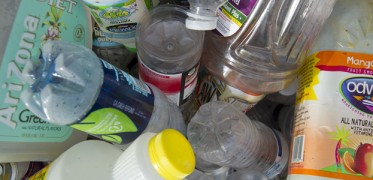Garbage Study Shows 60 Percent of Trash Could Be Diverted

A recently updated 2011 study by the University of Maine School of Economics that sorted and assessed the contents of trash in a representative sample of 17 Maine communities concludes that as much as 60 percent of what’s thrown away could be diverted from the waste stream through composting and recycling.
Since municipalities pay for trash disposal, usually by the ton, researchers say big savings could result from reducing volume of trash, along with the cost of hauling it and paying tipping fees for disposal, in addition to improving the environment.
The 2011 study involved sorting more than 30 subcategories of trash at transfer stations around the state. The subcategories were divided into three component groups: unsalvageable waste, compostable and organic materials, and recyclables.
“It was approximately 40-40-20 with waste, compostable and recyclable, respectively,” says Travis Blackmer, an economics graduate student from Dedham, Maine.
The research, commissioned by the Maine State Planning Office as a way to educate communities about the value of reducing waste by quantifying what’s being thrown away that needn’t be, “definitely accomplished what we wanted,” he says.
Statewide, Maine has consistently missed a desired goal of reusing, reducing or composting 50 percent of its waste stream. Some communities are more aggressive than others about reducing trash, but when presented with the potential cost savings, enthusiasm tends to grow, according to Blackmer and George Criner, director of the School of Economics who has researched trash in Maine for several decades. Most transfer stations have facilities for collecting glass, metal, paper and more, but much more even could be diverted.
“Wouldn’t we all agree that newspapers should be out of the garbage?” Criner says. “Yet many communities have noticeable amounts remaining in their curbside waste stream.”
Various types of recyclable or compostable paper made up about a quarter of all waste, according to the final report on the project, “2011 Maine Residential Waste Characterization Study.” Textiles, including clothing, are recyclable and comprised almost 5 percent of the waste stream that was analyzed, Blackmer adds.
The 2011 study has been augmented by data from several additional sources, which include the city of Brewer’s experience when it switched from traditional curbside trash collection to a single-sort recycling program in 2010 and then a “pay-as-you-throw” system.
“The pay-as-you-throw garbage system, coupled with the single-stream recycling option, is like a one-two waste-management punch,” Criner says. “Households respond to incentives, so when you hit them in the wallet, they want to throw out less, and since the single stream system is convenient, household participation is high. When Brewer put in its pay-as-you-throw and single-sort recycling, their waste essentially dropped to half, which is pretty typical.”
A single-sort system accepts multiple categories of recyclable trash in one container, which is later separated at a sorting facility.
Criner also says that recycling waste requires more labor than landfilling or incineration, and it creates jobs. Further recycling keeps materials from incineration or landfilling, and both have long-term environmental impacts. The economics of recycling is complex, depending on many varying factors, Criner says, but communities can save money if it is done wisely.
Contact: George Criner, (207) 581-3151; George Manlove, (207) 581-3756
